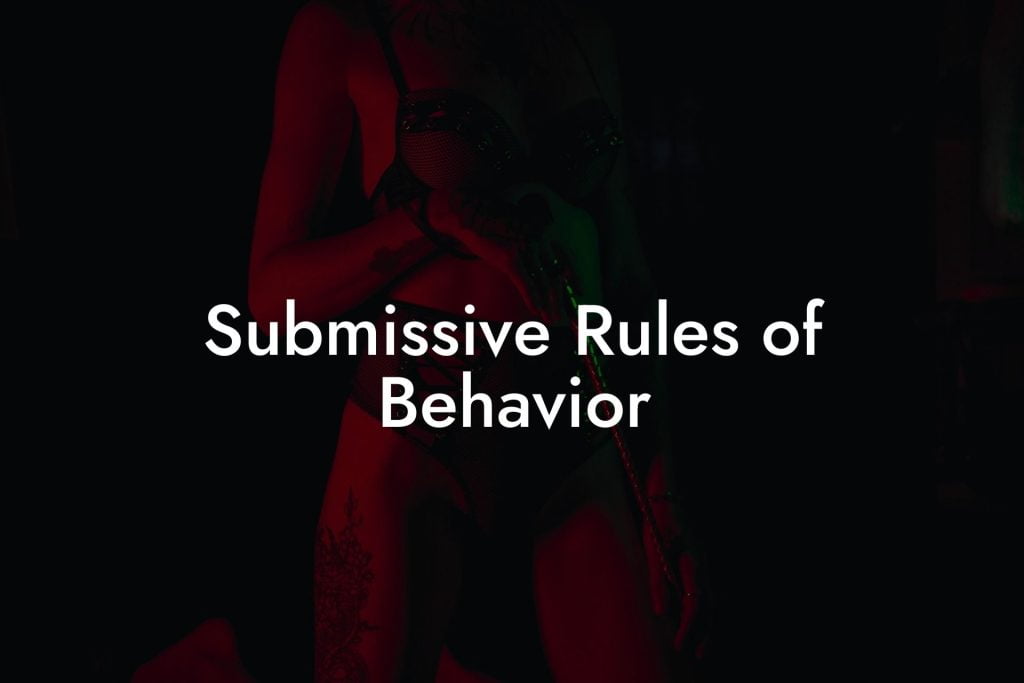In the bedroom, power dynamics can take on a whole new level of excitement and pleasure. The world of BDSM, with its Sub Dom relationships, provides an avenue for exploring these dynamics in a consensual, enthusiastic, and safe manner. Whether you are new to the scene or already a seasoned player, understanding the rules that govern the Sub Dom relationship is crucial for a fulfilling and satisfying experience. In this article, we will delve into the essential Sub Dom rules that lay the foundation for a successful journey of dominance and submission.
1. The Importance of Consent:
Consent is the cornerstone of the BDSM community, and it holds particular significance in the Sub Dom relationship. Both the Dominant and the submissive willingly and enthusiastically participate in the power exchange dynamic. Establishing consensual boundaries, safewords, and ongoing communication is fundamental to ensure that trust is built and maintained throughout the experience.
2. Communication and Negotiation:
Effective communication is key in any relationship, but it becomes even more crucial in a Sub Dom dynamic. Clear, open, and honest communication between the Dom and Sub is essential to ensure both parties understand each other's desires, limits, and expectations. Regular check-ins, discussing fantasies, and negotiating scenes help maintain a healthy and consensual power exchange.
3. Setting Rules and Boundaries:
In a Sub Dom relationship, the Dominant often establishes rules and protocols that the submissive is expected to follow. These rules can vary depending on the desires and needs of the individuals involved. They can range from tasks, rituals, and protocols to control aspects of the submissive's life. Establishing these rules should be a collaborative process, ensuring that the submissive's limitations and hard limits are considered.
4. Trust and Safety:
Trust forms the foundation of any Sub Dom relationship. The submissive places their trust in the Dominant to guide and protect them, while the Dominant must prioritize the well-being and consent of the submissive. It is crucial to establish a safe environment where both parties feel secure to explore their desires and boundaries.
5. Aftercare:
Aftercare plays a vital role in the Sub Dom relationship. After an intense scene, both the Dominant and submissive require emotional and physical support. This nurturing practice ensures that both partners are cared for and allows for the processing of intense emotions that may arise during BDSM play.
Sub Dom Rules Example:
Imagine a Sub Dom couple, Alex and Madison. They have been together for several years and have discovered their shared interest in BDSM. After thorough communication and negotiation, they establish their Sub Dom dynamics, with Madison assuming the submissive role and Alex as the Dominant. They set rules and boundaries with Madison agreeing to specific tasks and protocols, such as addressing Alex as "Sir" and asking for permission before engaging in certain activities. Trust, consent, and open communication are integral to their relationship, allowing them to explore their desires and maintain a strong connection.
Frequently Asked Questions
What is a BDSM contract?
A BDSM contract is a document that outlines the terms and boundaries of a BDSM relationship between consenting adults. It's designed to communicate expectations, define limits, and establish the roles and responsibilities of the participants. While not legally binding, it serves as a symbolic agreement ensuring clarity and consensual play among partners.
Why are BDSM contracts important?
BDSM contracts are important because they enhance communication, affirm boundaries and consent, and create a framework for trust within the power dynamics of a BDSM relationship. Contracts help to avoid misunderstandings and establish a sense of safety and respect for each participant's limits and preferences.
What should be included in a BDSM contract?
A BDSM contract should include the names of the participants, descriptions of their roles, duration of the agreement, limits and boundaries, safe words, health and safety measures, privacy considerations, and any other specific rules or protocols agreed upon by the parties involved.
Is consent in BDSM different from consent in a traditional relationship?
Consent in BDSM involves explicit, informed, and voluntary agreement to engage in specific activities within pre-negotiated boundaries. It is often more structured and detailed than in traditional relationships, due to the nature of the practices involved. Ongoing consent is vital, and it should be clear that it can be withdrawn at any time.
How does trust play a role in BDSM dynamics?
Trust is fundamental in BDSM relationships as participants are often in vulnerable positions. Trust ensures that boundaries are respected, consent is maintained, and that there's a safe space for the expression of desires and the exploration of power exchange dynamics.
What is a safe word, and why is it important?
A safe word is a pre-agreed signal used by participants to pause, slow down, or stop a BDSM scene immediately. It is vital for maintaining safety and ensuring that the activity does not surpass any personal limits.
Can a submissive withdraw consent mid-scene?
Absolutely. A submissive, or any participant, can withdraw consent at any point during a scene by using the safe word. All activities should cease immediately until further discussion determines the path forward.
How do you negotiate a BDSM scene?
Negotiating a BDSM scene involves discussing and agreeing upon various factors like roles, activities, limits, safe words, and aftercare. This negotiation should happen well in advance of the scene and be conducted in a non-sexual setting to ensure clarity and honesty.
What is aftercare in BDSM?
Aftercare refers to the attention and care provided after a BDSM scene. It can involve physical care, such as providing warmth and hydration, and emotional care, such as cuddling or debriefing the experience. Aftercare helps participants to transition back to everyday life and is crucial for emotional and physical well-being.
Are BDSM contracts legally enforceable?
No, BDSM contracts are not legally enforceable. They are symbolic tools for structuring and facilitating a mutual understanding between BDSM participants. However, they hold no standing in a court of law.
How often should a BDSM contract be reviewed?
BDSM contracts should be reviewed regularly, with the frequency depending on the needs and evolution of the relationship. Changes in personal limits, desires, and life circumstances can necessitate updates to the contract.
Can anyone participate in BDSM?
Anyone over the legal age of consent and with an understanding of safe, sane, and consensual practices can participate in BDSM. It's crucial to educate oneself and communicate openly with potential partners before engaging in any BDSM activities.
What if my desires change over time in a BDSM relationship?
It's natural for desires to evolve. Open communication with your partner about changes in your BDSM interests is crucial. The BDSM contract can be renegotiated to accommodate new desires or boundaries.
How can I bring up the idea of a BDSM contract with a partner?
Introduce the idea of a BDSM contract in a neutral setting. Share resources or examples of BDSM contracts and express how it could benefit the relationship. Ensure that the conversation welcomes mutual input and concerns.
Is BDSM dangerous?
BDSM, when practiced responsibly with a clear understanding of consent, trust, and safety, is not inherently dangerous. However, as with any sexual activity, it carries some risks. Therefore, it's essential to be educated about best practices and safety precautions.
How do I know if BDSM is right for me?
Understanding whether BDSM is right for you involves introspection, research, and self-awareness. You can start by reading about it, talking to experienced practitioners, and exploring your own boundaries and fantasies in a safe and consensual manner.
Can a BDSM contract be considered a living document?
Yes, a BDSM contract may be considered a living document as it can be modified to adapt to the relationship's changing dynamics. Regular revisions ensure that the contract remains relevant and reflective of the participants' current needs and desires.
Are there any resources available for writing a BDSM contract?
There are many resources available for writing a BDSM contract, including online templates, books, community forums, and workshops led by experienced BDSM practitioners. These can provide guidelines and inspiration for creating a personalized contract that meets the specific needs of those involved.
What can I do if I feel my boundaries have been violated in a BDSM context?
If you feel your boundaries have been violated in a BDSM context, it's important to communicate this to your partner as soon as possible. If needed, seek support from friends, the BDSM community, or a professional therapist. Your safety and well-being should always be the top priority.
How should I approach negotiations if I’m new to BDSM?
If you're new to BDSM, approach negotiations with openness and honesty about your experience level. Ask questions, express your boundaries clearly, and don't commit to anything you're not comfortable with. Consider working with a more experienced practitioner as a mentor or guide.
Do I need special equipment to practice BDSM?
Special equipment is not necessary to practice BDSM. Many aspects of BDSM involve psychological dynamics and do not require any gear. However, some practices may involve specialized equipment, which should be used responsibly and with proper knowledge of safety techniques.
By understanding and implementing the essential Sub Dom rules, you can embark on a journey of dominance and submission that is exciting, pleasurable, and fulfilling. Remember to prioritize consent, communication, and trust in all your interactions. If you want to dive deeper into the world of BDSM, explore our Ultimate BDSM Contract Pack, read other informative guides on Filthy Adult, and check out our diverse collection of fetish products in our online shop. Share this article with others who might be interested and embrace your desires with confidence and knowledge.













